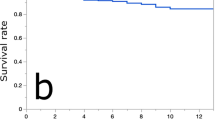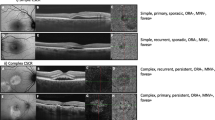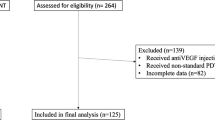Abstract
Background
The present study compared clinical features and outcomes of central serous chorioretinopathy (CSC) with and without pachychoroid.
Methods
It was a retrospective, longitudinal, record-based study which included eyes with CSC. Patients underwent spectral domain optical coherence tomography and differentiated between pachychoroid and non-pachychoroid groups. Eyes were divided into pachychoroid and non-pachychoroid groups based on the subfoveal choroidal thickness of 300 microns and the presence of pachyvessels.
Results
A total of 250 eyes of 250 patients were divided into pachychoroid and non-pachychoroid with 125 eyes in each group. Mean ages of patients in pachychoroid and non-pachychoroid groups were 45.7 ± 9.4 years and 47.4 ± 10.2 years, respectively. Mean initial best-corrected visual acuity (BCVA) was 0.40 ± 0.42 in pachychoroid and 0.39 ± 0.38 in non-pachychoroid group (p = 0.9). Mean final BCVA was 0.37 ± 0.9 in pachychoroid and 0.21 ± 0.33 in non-pachychoroid group (p = 0.04). 36 (28.8%) eyes in pachychoroid and 60 (48%) eyes in non-pachychoroid group had spontaneous resolution of CSC (p = 0.007). A total of 39 (31.2%) eyes in pachychoroid and 13 (10.4%) in non-pachychoroid group had recurrent CSC at the end of follow-up.
Conclusion
CSC eyes with pachychoroid had more recurrent episodes and less spontaneous resolution compared to CSC eyes in non-pachychoroid group. Final visual acuity was worse in eyes with CSC and pachychoroid. These findings need to be validated in a larger sample size with a prospective study design.
This is a preview of subscription content, access via your institution
Access options
Subscribe to this journal
Receive 18 print issues and online access
$259.00 per year
only $14.39 per issue
Buy this article
- Purchase on Springer Link
- Instant access to full article PDF
Prices may be subject to local taxes which are calculated during checkout




Similar content being viewed by others
Data availability
The data that support the findings of this study are not openly available due to reasons of sensitivity and are available from the corresponding author upon request. Data are located in controlled access data storage archives at Sankara Nethralaya, Kolkata, India.
References
Semeraro F, Morescalchi F, Russo A, Gambicorti E, Pilotto A, Parmeggiani F, et al. Central serous chorioretinopathy: pathogenesis and management. Clin Ophthalmol. 2019;13:2341–52.
Tanaka C, Iwahashi C, Komuku Y, Hozumi K, Mitarai K, Gomi F. Clinical characteristics of central serous chorioretinopathy in patients by age. Jpn J Ophthalmol. 2021;65:761–8.
Kanda P, Gupta A, Gottlieb C, Karanjia R, Coupland SG, Bal MS. Pathophysiology of central serous chorioretinopathy: a literature review with quality assessment. Eye (Lond). 2022;36:941–62.
Mazzeo TJMM, Leber HM, da Silva AG, Freire RCM, Barbosa GCS, Criado GG, et al. Pachychoroid disease spectrum: review article. Graefes Arch Clin Exp Ophthalmol. 2022;260:723–35.
Warrow DJ, Hoang QV, Freund KB. Pachychoroid pigment epitheliopathy. Retina. 2013;33:1659–72.
Arrigo A, Aragona E, Bordato A, Calamuneri A, Moretti AG, Mercuri S, et al. Acute central serous chorioretinopathy subtypes as assessed by multimodal imaging. Transl Vis Sci Technol. 2021;10:6.
Dansingani KK, Balaratnasingam C, Naysan J, Freund KB. En face imaging of pachychoroid spectrum disorders with swept-source optical coherence tomography. Retina. 2016;36:499–516.
Balaratnasingam C, Lee WK, Koizumi H, Dansingani K, Inoue M, Freund KB. Polypoidal choroidal vasculopathy: a distinct disease or manifestation of many? Retina. 2016;36:1–8.
Pang CE, Freund KB. Pachychoroid neovasculopathy. Retina. 2015;35:1–9.
Ravenstijn M, van Dijk EHC, Haarman AEG, Kaden TR, Vermeer KA, Boon CJF, et al. Myopic presentation of central serous chorioretinopathy. Retina. 2021;41:2472–8.
Imamura Y, Fujiwara T, Margolis R, Spaide RF. Enhanced depth imaging optical coherence tomography of the choroid in central serous chorioretinopathy. Retina. 2009;29:1469–73.
Cheung CMG, Lee WK, Koizumi H, Dansingani K, Lai TYY, Freund KB. Pachychoroid disease. Eye (Lond). 2019;33:14–33.
Spaide RF. The ambiguity of pachychoroid. Retina. 2021;41:231–37.
Castro-Navarro V, Behar-Cohen F, Chang W, Joussen AM, Lai TYY, Navarro R, et al. Pachychoroid: current concepts on clinical features and pathogenesis. Graefes Arch Clin Exp Ophthalmol. 2021;259:1385–400.
Battaglia Parodi M, Arrigo A, Iacono P, Falcomatà B, Bandello F. Central serous chorioretinopathy: treatment with laser. Pharmaceuticals (Basel). 2020;13:359.
Author information
Authors and Affiliations
Contributions
SB was responsible for designing the protocol, writing the protocol, conducting the search, screening potentially eligible studies, extracting and analysing data and interpreting results. KS was responsible for designing the protocol, screening potentially eligible studies, interpreting the results and writing the report. SD was responsible for designing the protocol, writing the protocol and providing feedback on the report. SG was responsible for writing the abstract and report, analysing the data, extraction of data, writing the summary and providing feedback on the report. ZD was responsible for the extraction of data, writing the report and providing the feedback on report. RR was responsible for designing the protocol, writing the protocol, conducting the search, creating a summary of findings, writing the report and providing feedback on the report.
Corresponding author
Ethics declarations
Competing interests
The authors declare no competing interests.
Additional information
Publisher’s note Springer Nature remains neutral with regard to jurisdictional claims in published maps and institutional affiliations.
Rights and permissions
Springer Nature or its licensor (e.g. a society or other partner) holds exclusive rights to this article under a publishing agreement with the author(s) or other rightsholder(s); author self-archiving of the accepted manuscript version of this article is solely governed by the terms of such publishing agreement and applicable law.
About this article
Cite this article
Bhattacharyya, S., Saurabh, K., Das, S. et al. Presentation and outcome of central serous chorioretinopathy with and without pachychoroid. Eye 38, 127–131 (2024). https://doi.org/10.1038/s41433-023-02645-2
Received:
Revised:
Accepted:
Published:
Issue Date:
DOI: https://doi.org/10.1038/s41433-023-02645-2



